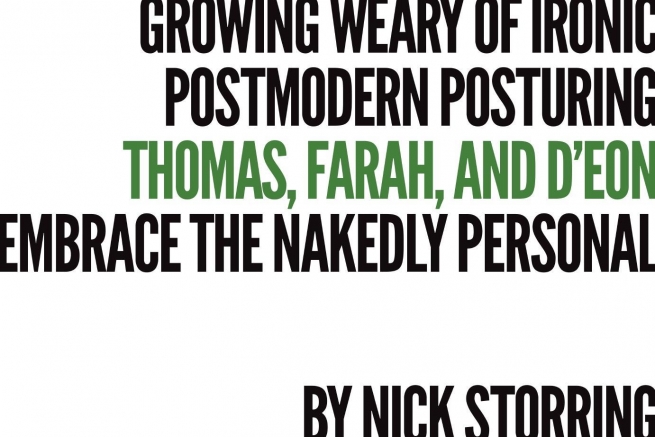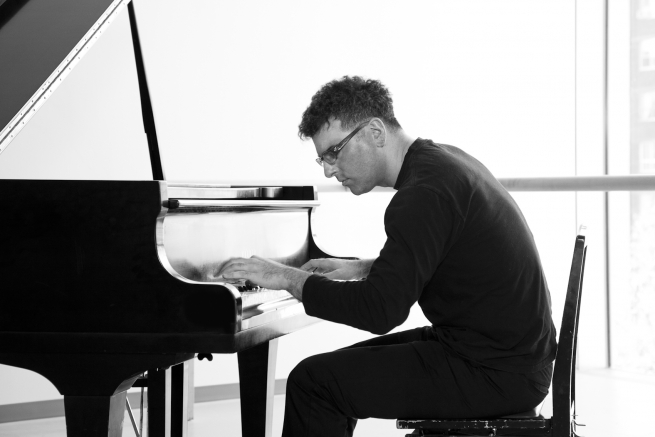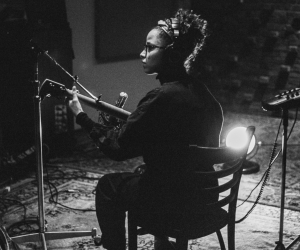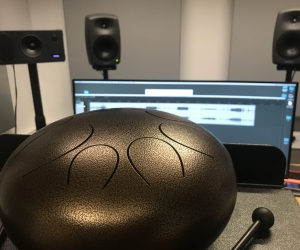I’m sitting with Thom Gill and we’re talking about his most recent EP Such Is Your Triumph, arguably his most intimate and personal set of recordings to date. In addition to his beautifully hushed and harmonically inventive takes on two gospel songs made famous by the Clark Sisters, the EP also contains several original pieces, including Triumph, which also delves into spiritual matters.
Then, out of nowhere, something he says causes me to freeze. “Triumph is actually about Justin Bieber.” Gill notes casually, without the merest smirk, chuckle, or any indication that he’s equivocating or being facetious. While he manages to reconcile the ostensibly religious lyrics with this seemingly outlandish claim, the moment seems to encapsulate the paradoxical nature of his music—and, for that matter, of a lot of music currently being produced.
Over the latter part of the past decade, there’s been a notable, albeit slow, shift away from ironic postmodern posturing toward personal integrations of diverse—and sometimes outré—musical styles, often serving resolutely sincere and even serious purposes. Even just a few years ago, the concepts of disrupting the perceived boundaries between high and low art—or at least, of commenting on its disintegration—of sampling and citation, and of adopting self-conscious fragmentation, diversity, and contradiction, still felt very novel and exciting. Even today, there’s still plenty of tongue-in-cheek covers, conspicuous pluralism, awkward remixes, carefully botched plagiarism, and studiously thought-out high-low mashups. But these postmodern tactics have become less and less relevant, and have even begun to feel dated. For younger artists who have spent their formative years steeping in a confused stew of things like YouTube, blogs, social media, and file sharing, this stuff doesn’t so much read as an intriguing conceptual ruse, but as reality. In other words, the irony can end up being lost on them.
The cultural studies and lit-crit realm has already offered a few interesting, if preemptive, obituaries for postmodernism—not to mention terminological tools for identifying and discussing the various theoretical and artistic practices that have arisen in the wake of postmodernism. One such term is metamodernism, which draws its meta- prefix more from Plato’s metaxy—the space between poles—than from the other meta (beyond), found in mumerous PoMo neologisms.
The term, quite appropriately, has been given a lot of its visibility by the webzine Notes on Metamodernism, which speaks to the trend. The zine compares metamodernism to a pendulum oscillating between multiple opposites all at the same time: from apathetic irony to genuine enthusiasm, from unity to plurality, pragmatism to utopianism—in the words of one of the zine’s editorials, in “a continuous oscillation between (i.e. meta-) seemingly modern strategies and ostensibly postmodern tactics as well as a series of practices and sensibilities ultimately beyond (i.e. meta-) these worn out categories.”
One of many recent musicians whose output confronts listeners in this polarized manner is Thom Gill, who works under the mononym THOMAS. His music confronts listeners in this polarized manner, placing a disarming sincerity and vulnerability amidst a peculiar array of stylistic cues. Gill’s soundworld is informed by his own disparate pantheon of pop figures, most of them unfashionable—Jane Siberry (a.k.a. Issa), Everything But The Girl, Swing Out Sister—but also borrows freely from the past thirty years of R&B, recent gospel music, his jazz training, and left-field dance music. Prince is another crucial jumping-off point. Like His Purpleness, Thom is a multi-instrumentalist and producer—his production and slyly virtuosic guitar work are both indispensable to THOMAS. He also shares affinity for embracing seemingly contradictory elements, both sonically and lyrically. He openly admires Prince for “conflating romantic love with a greater love,” yet his diversity never feels like some kind of blasé masquerade ball, nor do the lyrics feel like an art-school fishing expedition. Since his debut recording Self Help (2008), Gill’s lyrics have grown increasingly introspective and spiritually minded, and he’s remained musically anchored in a bewilderingly eclectic and sophisticated pop palette. The Wonderful Child, from 2011’s cassette release Breath, is an example:
a wonderful child has allowed me to see myself up close
a wonderful child has helped me
avoid all of the pain i used to hide behind
he urges me to question his authority
he asks me am i prospering
i say i hope to soon
The blatant, though elliptical, Christ-themed lyrics are set to the deadened pulse of a drum machine (the sort of pulse you’d hear from a parlour organ), while woozily ecclesiastical keyboard timbres trace a circuitous harmonic progression. Elsewhere on the same release, you hear shades of new jack swing house music and a k. d. Lang cover, all injected with Gill’s unique and imaginative melodic-harmonic tics, and lyrics that express a rather complicated relationship with spirituality, religious iconography, and love.
This is an utterly perplexing proposition for those attuned to the prevailing postmodern sensibility. After all, slap bass, covers of MOR artists, and allusions to Christianity could only be some big smarty-pants joke, right? The answer is actually a steadfast “Not at all.” While the conceptual framework offered by the editors of Notes on Metamodernism hinges on a pendulum-type motion, it would seem that many of those who are exemplary participants in this discourse actually tend to remain firmly swung over to the sincere side of things, insofar as their artistic vision is concerned. In conversation, Gill illustrates this by saying, “I feel like you should just be making the music you want to make and are moved to make . . . I just never ask questions about what I’ve done. It just sort of comes. I know that sounds weird, but it just flows out of me. I don’t sit down and choose a synth patch because it sounds like Michael McDonald; that’s cheeky. I’m not ever sidestepping the goal of making music that’s coming out of me. In that way, I’m always making music that’s serious.” Needless to say, conceiving of this oscillation movement in simple terms actually risks steamrollering Gill’s rather singular orientation, which is devoid of irony, and entirely committed to something very serious.
For THOMAS and many others, it’s as though the combination of new-media technologies and the repeated dredgings-up of disused popular culture from the ’80s to the early ’00s engendered a reevaluation of that which may have been formerly treated as token low-brow totems. In other words, they’re immersed in this culture rather than commenting on it from the mezzanine.
In metamodern work like that of THOMAS, this polar oscillation is felt more like an aesthetic effect of the music, which is heard in the conflicted critical response the music elicits rather than in the outlook of the artists themselves. On the one hand, the music is definitely indebted to a legacy of sardonic parody and fragmented citation, as it is clear that these artists somehow relate to their stylistic forebears through a technological lens of postmodern displacement. Yet the sincerity and sensitivity with which these raw materials are handled diverges greatly from the arch aloofness of the postmodern position.
The music of Toronto-based composer-pianist, John Kameel Farah presents an aesthetic paradigm which poses a deeper sort of friction in its explosive fusion of different idioms. Farah’s very personal amalgam of daring aesthetic choices has been running against the current for some time now. Emerging at a time when electronic music has moved toward terse minimalist abstraction, and other forms of experimentalism are also embracing hazy low fidelity, glitch, and anti-musicianship, Farah offers something that is quite the opposite: sturdy and highly polished epics that blend piano, wide-angle electronics, and elaborately programmed beats. Farah’s pieces thrive on the inherent tension within the elements of his work: structure, harmony, rhythmn, and style. The core of his work is his expansive and virtuosic piano playing. Although the depth of his abilities is tangible right on the surface, what he’s doing is a far cry from the kind of trite histrionics that people tend to rail against. Instead, it is actually evocative of a lineage of keyboardist-composers that encompasses Scriabin, Sorabji, and even Alice Coltrane, especially in terms of Farah’s opaque harmonies, generous ornamentation, and wide dynamic spectrum. Although this mystic branch of Romanticism informs his work, Farah often seeks to relate himself to his Palestinian heritage by way of absorbing various aspects of Arabic music in the structures, techniques, and even instrumental timbres in his work. Traits of Renaissance and baroque keyboard music and of jazz are also audibly embedded within his work. Even the rhythmic drive and sheer heaviness of metal music has made a significant impact on his approach.
The proposition of Farah’s music grows even more complex when his integration of electronics is taken into account. While it is as formally rich and dynamic as his piano composition, it extends the stylistic scope of his music into uncharted territory. On top of fashioning hallucinatory orchestral arrangements from manipulated instrumental timbres and synthetic tones, he also cuts jagged shapes into his compositions by deploying dense, rapid-fire percussion programming, and sometimes even decimated breakbeats. For some listeners the beat component is problematic, as it could be framed as a threat to the “serious music” language presented elsewhere in the music. But these criticisms are tied up in the issues tackled by PoMo both in terms of style and the erosion of high and low culture. Farah’s perspective on these materials, however, refreshingly hinges upon the notion of artists humbling themselves to history’s natural course: “I was never immersed in the currentness of certain scenes, and I perceive them very much from the outside. I just think of various sounds as tools I can use to express myself,” Farah says, and continues: “Some tracks of mine have used breakbeats. One’s perception of that depends completely on the timescale that you’re viewing things [in]. If you view things on a fifteen-year timescale, or even forty years, something that is considered four years out-of-date falls within pretty sensitive timelines for you. But if your frame of reference spans hundreds of years, going back to late medieval, early Renaissance, bordering with Arabic music, that’s a significantly larger timescale—so who cares whether something’s been out of date for nine years or twelve years or something like that? Other things I’m using are 400 years out of date and it’s all just fodder, it’s all just material for me. It actually just shows that it’s all going to be ancient one day.”
Most importantly, Farah is earnestly committed to his work, and he sees it as offering reflections upon various serious and pertinent issues, rather than a series of scattershot quips and meta-commentaries. “Music is a bit of a Trojan horse. Although my fusion of styles comes out very naturally, there is a completely intentional agenda behind all of it. It’s difficult to explain the whole picture, but part of it is a broader cultural agenda, especially with regard to the Middle Eastern aspect of my music. There’s an attempt to push and expand the idea of Middle Eastern music—what it can be and what qualifies it as such. Also, ways that it can be integrated that go way beyond terrible East-meets-West shit, that strikes at something real—making real connections. [I’m] making artistic decisions that are powered by an interest in those things, but my interest goes beyond just being into Middle Eastern music or Middle Eastern food or the last fifty years of Middle Eastern history.” Farah’s music makes these connections in a sincere attempt to define the context of music now, “My music rearranges and de-arranges and transforms all of these various cultural—classical, contemporary, electronic, Arabic—elements in really strange ways; not just randomly slapping them together, but permuting them in a way that is informed by my own historical understanding. In my music, I am imagining myself casting a through-line or a hook, as far back as you possibly can, to try to understand how we got where we are now. My work is basically just this impossible attempt to try to do that: pondering this admittedly quixotic and lofty idea. I’m reflecting on these concepts without really getting answers, yet I hope that in some way I’m inspiring others to reflect on this idea too.”
It’s clear that although contemporary artists are grappling with their broader aspirations, and recognize the problems inherent in ambition, there is nonetheless a return to ideas at which the most cynical strains of postmodernism balked.
Montreal-based Haligonian D’Eon (Chris D’Eon) is another musician whose work speaks to this emerging aesthetic quandary. Taking what sounds like the echoes of an ’80s quiet storm ballad and grafting it onto the robust bass swells and drum clatter of everything—jungle, juke, and recent top-40 R&B—he can also, at times, suggest Terry Riley’s keyboard kaleidoscopes, or the surly squelches of an Aphex Twin side project. Watching his live theatrics, it can be all too easy to draw certain conclusions about the sources of his anxiously buoyant experimental pop. Long hair flailing about while he sings, D’Eon grimaces and gestures in the air as he executes a technicolour keyboard riff or pounds out a syncopated drum pattern on his sampler. Sit him down and engage with him about his music, and it becomes clear that his onstage behaviour is actually the furthest thing from a stage persona.
When D’Eon talks about his formative musical experiences, his effusive candour is immediately palpable. “When I was eleven and taking piano lessons at Acadia University, I snuck into the MIDI Lab in the Library, where they had CDs and records—mostly classical music—and stereos where you could listen to the records. Nobody was around; it was summer. And I found a box set of Steve Reich. I listened to every single fucking CD in that box set in a row, over the course of five days. It totally recalibrated my entire musical perspective.” He also waxes poetic about the premillenial surge of electronica, about D’Angelo, about about his love of the Yamaha DX7, and even about various Middle Eastern musics.
Riding a wave of cyber-hype following a split release—Darkbloom, with fellow Montrealer Grimes—D’Eon is wrapping up a much larger follow-up project where he intends to allow his mutant R&B to sprawl generously across several ambitious sidelong suites, akin to classic progressive-rock double LPs. D’Eon first appeared under his full name on a Divorce Records split-cassette with psychedelic band Omon Ra in late 2009. His contribution was mostly composed during his time in Dharamsala, India where he had been studying Tibetan music. The piece was strongly informed by his recent bouts of travelling and training, and featured intersecting melodies on sitar (which he had been studying with a family friend), oud, and baglama, over a bed of harmonium and “ghetto folk tablas.”
Following this initial release, he rapidly migrated away from this trippy Eastern-inspired palette and toward his bent take on pop. “It was 2009 and I had just gotten back from India, and I was in love with Western culture, so it was just like, ‘I wanna make pop music . . . like pop,’” he beams. Despite his enthusiasm for pop, one could hardly say that D’Eon is poised for top-40 stardom. Much like THOMAS, he is glimpsing pop through a prismic gaze which crystallized over the course of postmodernism’s reign. Something about his work is still too left-of-centre. He’s a bit too ambitious, too DIY, too restless, too contradictory to ascend to that level of popularity. As we speak he wrestles with the various elements in his own single, Transparency, whose video was quite successful this past summer. “On one hand you have the DX7 electric piano which is considered cheesy, and associated with the theme-song to Doogie Houser MD, or Celine Dion, or Phil Collins. The patch is there, but the chord progression never actually resolves to the tonic, and the lyrics are kind of apocalyptic. To me it’s more a question of confusion and putting something in a different context. I like that cognitive dissonance.”
While at ease with discussing context, for D’Eon it’s more a reflection of the current climate than a game of appropriation, “I feel like there’s a little bit of a change in the way people think of music as tasteful or distasteful. I feel like there’s much more tolerance for that kind of thing among [those in]my generation. I don’t really have guilty pleasures anymore: they’re just pleasures. In the previous decade, there was this huge sense of irony, whereas now it’s like, ‘Hey, wasn’t new jack swing cool?’ That shit was great! But it’s funny that there are certain kinds of music that are still distasteful to this open community where twenty-somethings who grew up on the Internet feel as though they’re free to listen to and make whatever kind of music they want.”
“When I was twelve or thirteen, in grade six or seven you had your alterna-rock and your R&B and boy-band pop, and it was considered very distasteful for the guys to listen to the R&B. I secretly loved Aaliyah and D’Angelo. But if I said I loved the song Untitled by D’Angelo when I was in junior high, that would not have had very good consequences. I would’ve had the shit beaten out of me. Now that my generation is in its twenties, we can dictate what’s tasteful. We can say. ‘I don’t give a shit . . . I listen to Aaliyah.’ And everybody loves Aaliyah now! I remember a few months ago when it was the tenth anniversary of her death, every white male that I know was like, ‘RIP Aaliyah’ on their Facebook page and on Twitter!”
Although things remain in transition, this new-found, irony-spurning, guilt-free spirit to eclecticism is certainly taking hold. Artists seem to be growing both weary and wary of cynical intellectual games, and are instead far more concerned with self-expression and even spirituality, like a cautious revisiting of Romanticism. In the cases of Farah, D’Eon, and Gill, they’re all but oblivious to the actual tenets of postmodernism, which is telling. In any case, this new—albeit complicated—sincerity has fused itself to the fragmented technological and cultural landscape, leading to work which is both intensely mediated and referential, yet nakedly personal.
Image of John Kameel Farah by: Jamie Day Fleck. Audio: Janela (2010). Composed by Thomas Gill. Performed by Thom Gill, synth, voice; Felicity Williams, voice; Bram Gielen, electric bass, voice; Christopher Willes, electronics, synth; Matthew Pencer, drum machine; Daniel Pencer, saxophone.




